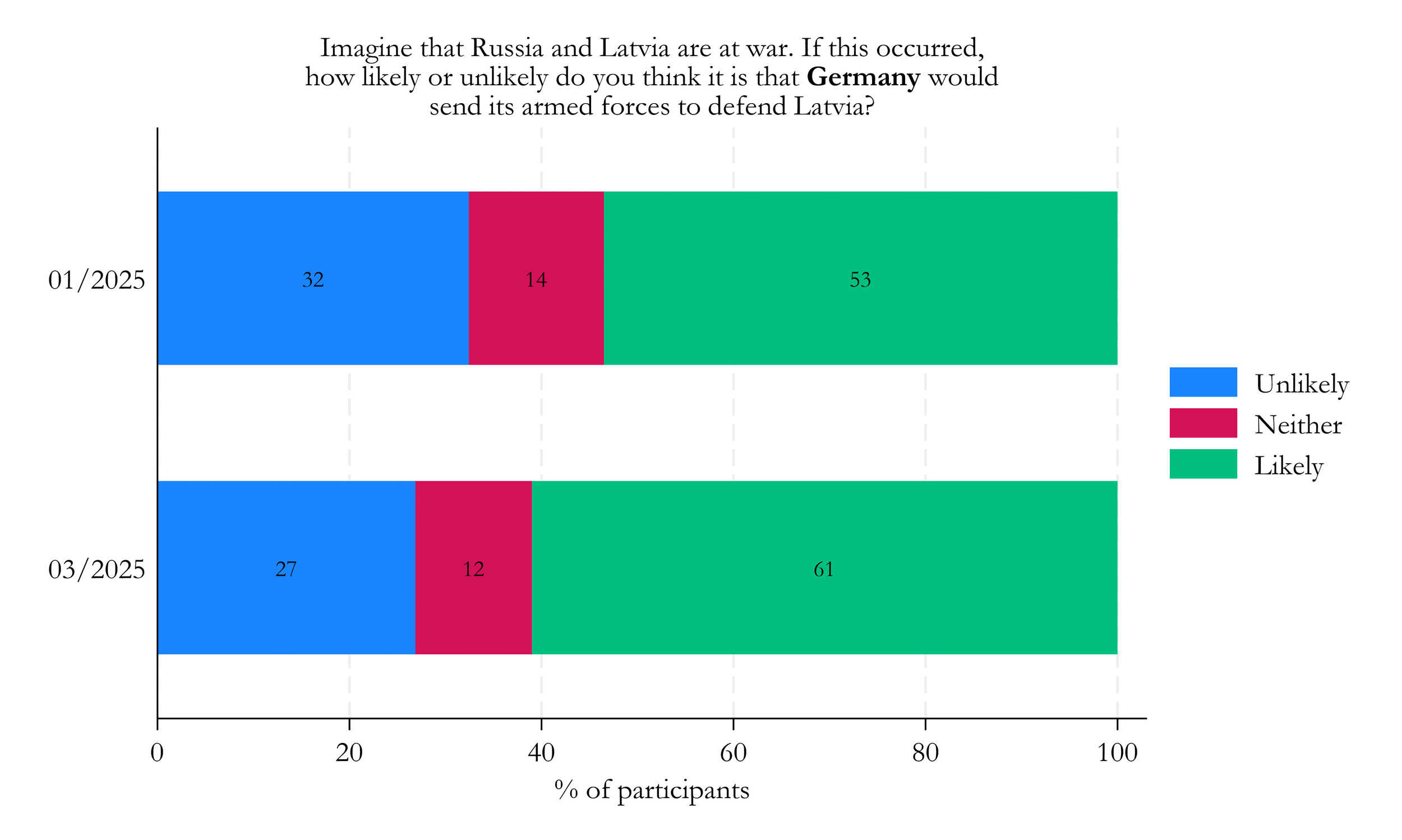How Russians View the Credibility of NATO’s Collective Defense Commitments
Study description
This study is part of a longitudinal investigation into Russian public views on NATO’s collective defense commitments (see “NATO’s Collective Defense Credibility during the Second Trump Administration: A Longitudinal Study in Russia”). In this broader project, our primary aim is to examine whether Trump’s rhetoric and approach to alliance management lead to shifts in perceptions of the strength of NATO’s collective defense commitments among the Russian population.
This report summarizes our findings for the first two waves of data collection: January 2025 and March 2025. In early March 2025, we experienced an unprecedentedly belligerent U.S. rhetoric toward European allies and Ukraine, a cessation of military assistance to Kyiv, and a rapprochement with Moscow. Some foreign policy commentators have noted that these significant events may have already damaged the credibility of U.S. commitments to NATO allies. The ad hoc March survey allows us to investigate the impact of these events by comparing the current views on collective defense credibility with those we found in our first survey round in January (see the preregistration protocol for this study).
Note that the corresponding analysis of views on collective defense in selected NATO countries (the United States, Canada, the United Kingdom, Germany, and Poland) is available in our first MICROCODE research report and the article recently published in the Bulletin of the Atomic Scientists.
Data collection procedure
We worked with a polling company, Levada, to field the survey to a representative sample of 1,600 Russian adult respondents via Levada’s regular omnibus survey—a nationwide, multi-stage, stratified probability sample poll of urban and rural populations. The statistical error does not exceed 3.4%.
Data analysis
Categorical plots below show percentages of respondents who selected the given response in January 2025 and March 2025 survey waves. To facilitate the interpretation of the substantive effects, we aggregated the responses on a seven-point Likert scale into three categories: Unlikely, Neither likely nor unlikely, and Likely. We also provide additional figures showing the differences for various sociodemographic subgroups in the Russian population.
The coefficient plot then visualizes the results of an ordinal regression analysis for the key survey item related to the credibility of U.S. commitments. The figure shows that the difference between the January and March 2025 survey waves holds even when controlling for different sociodemographic variables.
Results
(1) Likelihood of NATO Countries Defending the Baltics: Latvia is a NATO member state located in Eastern Europe. Imagine that Russia and Latvia are at war. If this occurred, how likely or unlikely do you think it is that the following would send their armed forces to defend Latvia?
Summary of results:
As our analysis shows, confidence in the credibility of the U.S. commitments to its East European NATO allies has further decreased during the past two months––from the (already fairly low) 53% of respondents who believed that U.S. intervention was “likely” in January 2025 to merely 48% in March 2025. This is in line with our research in selected NATO countries showing that the Trump administration’s rhetoric and policies made the public more skeptical about the strength of U.S. collective defense commitments.
However, we have not observed the same effect for the other NATO members. In fact, the Russian public is now more convinced that the United Kingdom, France, and Germany would defend their Baltic ally (7-8 percent point increase). Given this increase, the perceived likelihood that these three NATO countries would intervene militarily (the United Kingdom: 60%, France: 62%, Germany: 61%) is now comparable with Poland (63%). These findings may be explained by the muscular rhetoric coming from European NATO countries in the wake of the profound shift in the U.S. foreign policy in the first months of the second Trump administration.
As a result of these countervailing trends (decreased credibility of the U.S. commitments and increased credibility of the commitments made by European NATO allies), we see very little change in the perception of the NATO collective defense commitments overall during these two months (a shift from 63% to 64% likelihood).
Descriptive plots:
…United States
…United Kingdom
…France
…Germany
…Poland
…NATO as a whole
(2) Views on the credibility of U.S. commitments by demographic composition
Summary of results:
The plots below show the responses to the March 2025 survey item asking about the likelihood of U.S. military assistance to Latvia split by gender and age categories. We found that Russian men are significantly more skeptical about the likelihood of U.S. intervention (46% likelihood for men and 54% likelihood for women). Furthermore, there is a clear trend related to the age of our respondents: the older individuals were less convinced about the likelihood of U.S. military assistance than the younger respondents.
…by gender
…by age
(3) Regression analysis
Summary of results:
The regression plot shows the difference in the perception of the U.S. collective defense commitments between the two survey waves while controlling for various factors on the level of individuals and on the level of federal subjects these individuals come from. The dependent (outcome) variable is the perceived likelihood of U.S. assistance to Latvia in our scenario on a 7-point Likert scale from 1–Extremely unlikely to 7–Extremely likely. Error bars are 95% confidence intervals. Variables that overlap with the vertical line are statistically indistinguishable from 0. The change in the perceived credibility of U.S. commitments between the two survey waves (“Timeframe”) is statistically significant at p =.005.
Updated on March 31, 2025
Written by: Michal Smetana, Lauren Sukin, Marek Vranka and Ondřej Rosendorf
Funded by the European Union (ERC, MICROCODE, 101160767). Views and opinions expressed are however those of the author(s) only and do not necessarily reflect those of the European Union or the European Research Council. Neither the European Union nor the granting authority can be held responsible for them.











